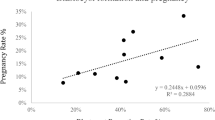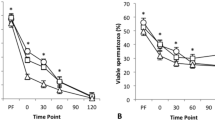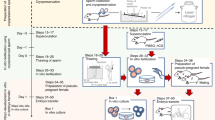Abstract
The production of recombinant proteins in the milk of transgenic animals is an alternative to traditional cell culture methodology. Transgenic rabbits can serve in the small-scale production of recombinant proteins, underscoring the need to maintain valuable transgenic lines. In this study, the authors used cryopreserved transgenic rabbit semen to artificially inseminate does, demonstrating the utility of this method for the reestablishment of a transgenic rabbit herd.
This is a preview of subscription content, access via your institution
Access options
Subscribe to this journal
We are sorry, but there is no personal subscription option available for your country.
Buy this article
- Purchase on Springer Link
- Instant access to full article PDF
Prices may be subject to local taxes which are calculated during checkout
Similar content being viewed by others
References
Hammer, R.E. et al. Production of transgenic rabbits, sheep and pigs by microinjection. Nature 315(6021), 681–683 (1985).
Meade, H.M. et al. in Gene Expression Systems: Using Nature for the Art of Expression (eds Fernandez, J.M. & Hoeffler, J.P.) 400–421 (Academic Press, San Diego, 1999).
Pollock, D.P. et al. Transgenic milk as a method for the production of recombinant antibodies. J. Immunol. Methods 231(1–2), 147–157 (1999).
Ziomek, C.A. Commercialization of protein produced in the mammary gland. Theriogenology 49(1), 139–144 (1998).
Vicente, J.S. & Viudes-de-Castro, M.P. A sucrose-DMSO extender for freezing rabbit semen. Reprod. Nutr. Dev. 36(5), 485–492 (1995).
Wales, R.G. & O'Shea, T. The deep freezing of rabbit spermatozoa. Aust. J. Biol. Sci. 21(4), 831–833 (1968).
FDA Center for Biologics Evaluation and Research. Points to Consider in the Manufacture and Testing of Therapeutic Products for Human Use Derived from Transgenic Animals. (1995). http://www.fda.gov/cber/gdlns/ptc_tga.txt.
Gavin, W. The future of transgenics. Regulatory Affairs Focus 6, 13–19 (2001).
Baguisi, A. et al. Production of goats by somatic cell transfer. Nat. Biotechnol. 17(5), 456–461 (1999).
Dalimata, A.M. & Graham, J.K. Cryopreservation of rabbit spermatozoa using acetamide in combination with trehalose and methyl cellulose. Theriogenology 48(5), 831–841 (1997).
Blash, S., Melican, D. & Gavin, W. Cryopreservation of epididymal sperm obtained at necropsy from goats. Theriogenology 54(6), 899–905 (2000).
Acknowledgements
The authors gratefully acknowledge the help and hard work of the Genzyme LARD staff, especially Joanne Fagan, Debbie Dimke, and Stephen Baker. We wish to thank Dr. Carol Ziomek and David Melican of GTC Biotherapeutics for their support and for critical review of this manuscript.
Author information
Authors and Affiliations
Corresponding author
Rights and permissions
About this article
Cite this article
Blash, S., Chen, L., Harvey, M. et al. Reestablishment of a transgenic rabbit line by artificial insemination using cryopreserved semen. Lab Anim 34, 61–63 (2005). https://doi.org/10.1038/laban0405-61
Received:
Accepted:
Issue Date:
DOI: https://doi.org/10.1038/laban0405-61



